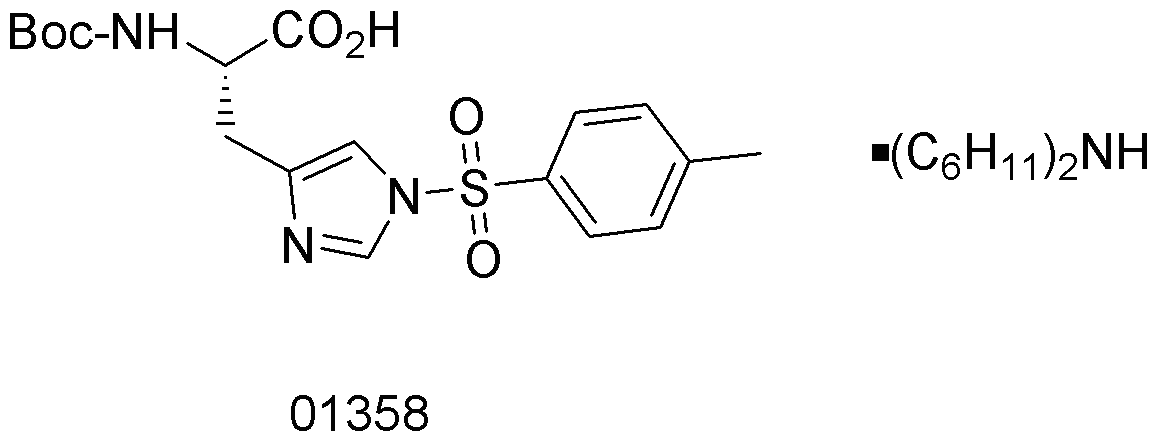Na-Boc-Nim-4-toluenesylfonyl-L-histidine dicyclohexylammonium salt is widely utilized in research focused on:
- Peptide Synthesis: This compound serves as a protecting group in the synthesis of peptides, allowing for selective reactions and improved yields in complex organic synthesis.
- Drug Development: It is employed in the pharmaceutical industry for the development of novel therapeutics, particularly in designing inhibitors for specific biological targets.
- Bioconjugation: The compound is useful in bioconjugation techniques, facilitating the attachment of biomolecules to surfaces or other molecules, which is crucial in diagnostics and therapeutic applications.
- Research in Cancer Therapy: Researchers utilize it to explore potential treatments for cancer, leveraging its unique properties to design compounds that can target cancer cells more effectively.
- Analytical Chemistry: It is applied in analytical methods for the detection and quantification of various biomolecules, enhancing the sensitivity and specificity of assays.
General Information
Properties
Safety and Regulations
Applications
Na-Boc-Nim-4-toluenesylfonyl-L-histidine dicyclohexylammonium salt is widely utilized in research focused on:
- Peptide Synthesis: This compound serves as a protecting group in the synthesis of peptides, allowing for selective reactions and improved yields in complex organic synthesis.
- Drug Development: It is employed in the pharmaceutical industry for the development of novel therapeutics, particularly in designing inhibitors for specific biological targets.
- Bioconjugation: The compound is useful in bioconjugation techniques, facilitating the attachment of biomolecules to surfaces or other molecules, which is crucial in diagnostics and therapeutic applications.
- Research in Cancer Therapy: Researchers utilize it to explore potential treatments for cancer, leveraging its unique properties to design compounds that can target cancer cells more effectively.
- Analytical Chemistry: It is applied in analytical methods for the detection and quantification of various biomolecules, enhancing the sensitivity and specificity of assays.
Documents
Safety Data Sheets (SDS)
The SDS provides comprehensive safety information on handling, storage, and disposal of the product.
Product Specification (PS)
The PS provides a comprehensive breakdown of the product’s properties, including chemical composition, physical state, purity, and storage requirements. It also details acceptable quality ranges and the product's intended applications.
Certificates of Analysis (COA)
Search for Certificates of Analysis (COA) by entering the products Lot Number. Lot and Batch Numbers can be found on a product’s label following the words ‘Lot’ or ‘Batch’.
*Catalog Number
*Lot Number
Certificates Of Origin (COO)
This COO confirms the country where the product was manufactured, and also details the materials and components used in it and whether it is derived from natural, synthetic, or other specific sources. This certificate may be required for customs, trade, and regulatory compliance.
*Catalog Number
*Lot Number
Safety Data Sheets (SDS)
The SDS provides comprehensive safety information on handling, storage, and disposal of the product.
DownloadProduct Specification (PS)
The PS provides a comprehensive breakdown of the product’s properties, including chemical composition, physical state, purity, and storage requirements. It also details acceptable quality ranges and the product's intended applications.
DownloadCertificates of Analysis (COA)
Search for Certificates of Analysis (COA) by entering the products Lot Number. Lot and Batch Numbers can be found on a product’s label following the words ‘Lot’ or ‘Batch’.
*Catalog Number
*Lot Number
Certificates Of Origin (COO)
This COO confirms the country where the product was manufactured, and also details the materials and components used in it and whether it is derived from natural, synthetic, or other specific sources. This certificate may be required for customs, trade, and regulatory compliance.

